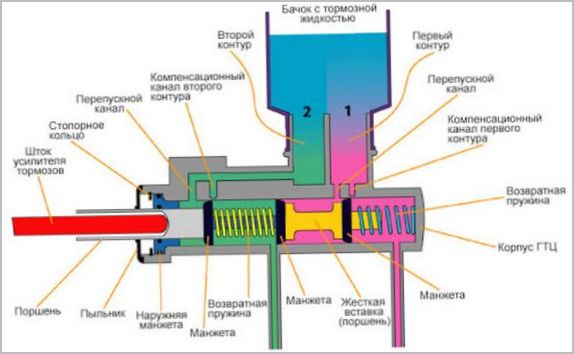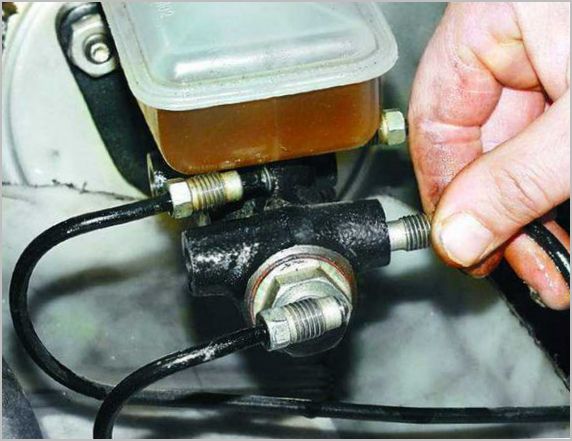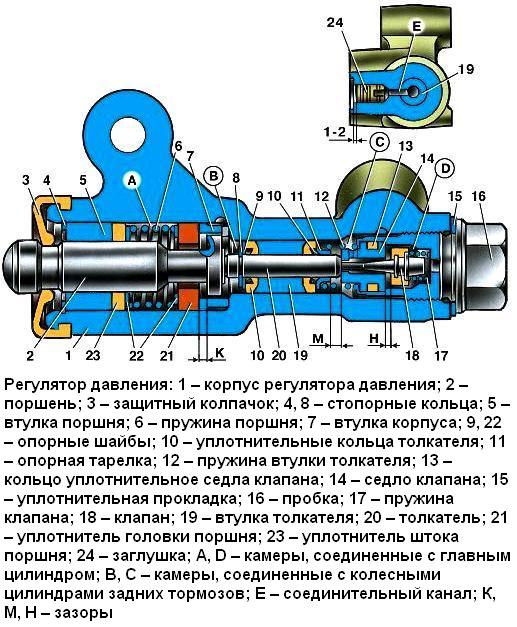
Master brake cylinder - device and principle of operation
The first function of the hydraulic drive of the car's brakes is to convert the force of pressing the pedal into a fluid pressure proportional to it in the lines. This is done by the main brake cylinder (GTZ), located in the area of \uXNUMXb\uXNUMXbthe motor shield and connected by a rod to the pedal.

What should the GTC do?
Brake fluid is incompressible, so to transfer pressure through it to the pistons of the executive cylinders, it is enough to apply force to the piston of any of them. The one that is specifically designed for this and is connected to the brake pedal is called the main one.
The first GTZ were arranged to primitiveness simply. A rod was attached to the pedal, the second end of which pressed on a piston with an elastic sealing cuff. The space behind the piston is filled with fluid exiting the cylinder through the pipe union. From above, a constant supply of fluid contained in the storage tank was provided. This is how the clutch master cylinders are now arranged.
But the brake system is much more important than clutch control, so its functions should be duplicated. They did not connect two cylinders to each other; a more reasonable solution was to create one GTZ of a tandem type, where two pistons are located in series in one cylinder. Each of them works on its own circuit, leakage from one has almost no effect on the operation of the other. The contours are distributed over the wheel mechanisms in different ways, most often the diagonal principle is used, code, in case of any single failure, the brakes of one rear and one front wheel remain working, but not along one side, but along the diagonal of the body, left front and right rear or vice versa. Although there are cars where hoses of both circuits fit the front wheels, working on their own separate cylinder.
GTZ elements
The cylinder is attached to the engine shield, but not directly, but through a vacuum booster that makes it easier to press the pedal. In any case, the GTZ rod is connected to the pedal, vacuum failure will not lead to complete inoperability of the brakes.
The GTC includes:
- the cylinder body, inside which the pistons move;
- located at the top of the tank with brake fluid, having separate fittings for each of the circuits;
- two consecutive pistons with return springs;
- lip-type seals on each of the pistons, as well as at the rod inlet;
- a threaded plug that closes the cylinder from the end opposite the rod;
- pressure outlet fittings for each of the circuits;
- flange for mounting to the body of the vacuum booster.

The reservoir is made of transparent plastic, since it is important to have constant control over the level of brake fluid. Picking up air by pistons is unacceptable, the brakes will completely fail. On some vehicles, tanks are placed in a zone of constant visibility for the driver. For remote control, the tanks are equipped with a level sensor with indication of its fall on the instrument panel.
GTZ work order
In the initial state, the pistons are in the rear position, the cavities behind them communicate with the liquid in the tank. Springs keep them from spontaneous movement.
As a result of the effort from the rod, the first piston sets in motion and blocks the communication with the tank with its edge. The pressure in the cylinder increases, and the second piston begins to move, pumping liquid along its contour. Gaps are selected in the entire system, the working cylinders begin to put pressure on the pads. Since there is practically no movement of parts, and the fluid is incompressible, the further pedal travel stops, the driver only regulates the pressure by changing the effort of the foot. The intensity of braking depends on this. The space behind the pistons is filled with liquid through the compensating holes.

When the force is removed, the pistons return under the influence of the springs, the liquid again flows through the opening holes in the reverse order.
Reservation principle
If one of the circuits has lost its tightness, then the liquid behind the corresponding piston will be completely squeezed out. But a quick re-pressure will supply more fluid to the good circuit, increasing pedal travel, but the pressure in the good circuit will be restored and the car will still be able to decelerate. It is not only necessary to repeat pressing, throwing out more and more new quantities from the pressure tank through the leaky circuit. After stopping, it remains only to find a malfunction and eliminate it by pumping the system from trapped air.
Possible malfunctions
All GTZ problems are associated with seal failures. Leaks through the piston cuffs lead to fluid bypass, the pedal will fail. Repair by replacing the kit is ineffective, it is now customary to replace the GTZ assembly. By this time, the wear and corrosion of the cylinder walls has already begun, their restoration is not economically justified.
A leak can also be observed in the place where the tank is attached, here replacing the seals can help. The tank itself is strong enough, violations of its tightness are rare.

The initial removal of air from the new cylinder is carried out by filling it with liquid by gravity with the fittings of both circuits loosened. Further pumping is carried out through the fittings of the working cylinders.

